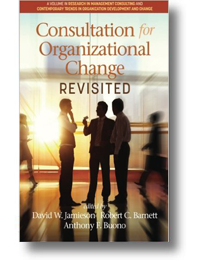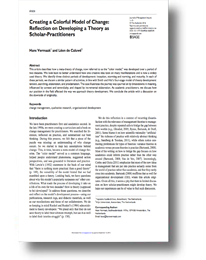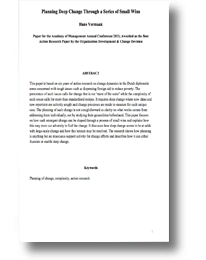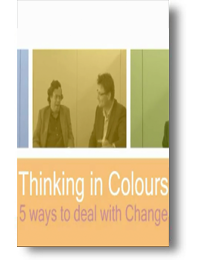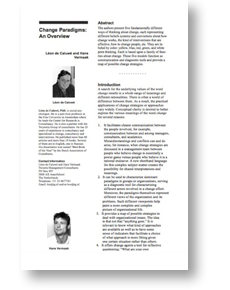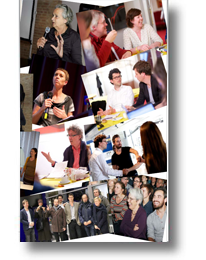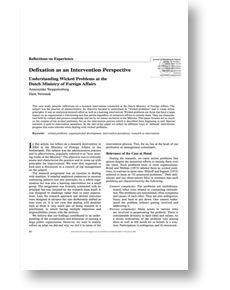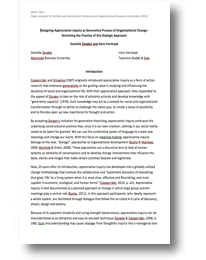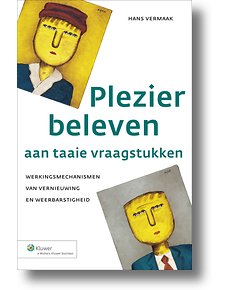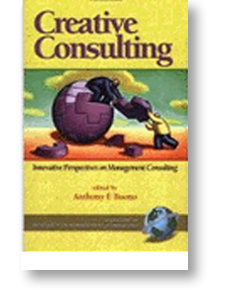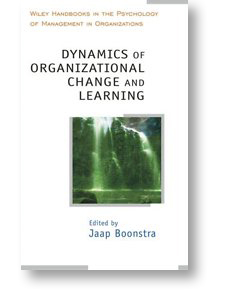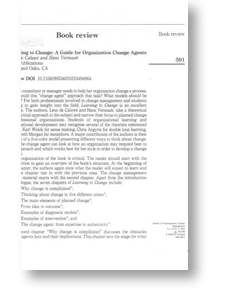This is the most up to date, complete and concise publication on the colors of change. It is written for both practitioners and academics that want to go beyond the basics. Those who already know about this change theory are likely to be surprised to find there is more to both the model and its applications Read more…
publications
The colors of change – revisited
In: R. Shani & D. Noumair. Research in Organizational Change and Development (vol. 26) - Emerald, 2018
Facilitating local ownership through paradoxical interventions
The complexity of tough issues can only be handled effectively with intensive local participation. Such participation is not straightforward as people may shy away from the unfamiliar repertoires, unpredictable processes and inevitable opposition that come with the territory. This paper focuses on how to facilitate local ownership in a series of paradoxical interventions with sufficient depth and credibility. Read more…
Circular venture building
Emerging Fundamentals
Few people disagree that circular ventures are a good thing. But how you make them a success is a different story. Three Dutch platforms joined forces to explore what enables a circular economy. As part of that research they invited an eclectic group of experts from different fields to share their thoughts and experiences Read more…
Democratization of change management
In 2018 four established consultants and change experts in their (late) thirties came to interview me for the Dutch national magazine for management consultants. (The Netherlands seems to have the highest density of such consultants in the world, by the way). They were looking for a good conversation about change as profession, democratization of change agents, professional standards and how to evaluate your own performance honestly Read more…
Collaborative transformation
The art of making international trade more sustainable
International trade can make a huge difference towards sustainability, as over half of what is produced globally crosses national borders. Several of the United Nations 2030 Sustainable Development Goals – such as realizing ‘zero hunger’ and ‘no poverty’, ensuring all have ‘decent work’, and taking ‘climate action’ – crucially depend on transforming the way international trade is organized. But international value chains are complicated, involving many different people working in diverse contexts that change over time. Therefore Read more…
Four contexts of action research
Crossing boundaries for productive interplay
This paper explores how action research takes place within and between four contexts: adding practical value, improving institutions, developing professions, and contributing to theory. We argue that action research is more than those activities conducted within these contexts: it is a process of handling the generative tensions in the boundary regions. Read more…
Learning to change
A guide for Organizational Change Agents
‘Learning to Change’ provides a comprehensive overview of organizational change theories and practices developed by both U.S. and European change theorists. The authors compare and contrast different approaches: five fundamentally different ways of thinking about change Read more…
Using causal loop diagrams to deal with complex issues
In: D. W. Jamieson, Barnett & A Buono (eds.) Consultation for Organizational Change Revisited - Information Age Publishing, 2016
A persistent stereotype of consultants is that of experts who have all the answers. However, the more complex problems are, the less consultants are able to provide ‘magical solutions’. Causal loop diagrams (CLDs) are a powerful tool to deal with issues characterized by content complexity and process complexity. Read more…
Creating a colorful model of change
Reflection on developing a theory as scholar-practitioners
This article describes how, almost twenty years ago, we came up with a meta-theory of change, now referred to as the “color model,” and how that theory has developed over time. We look back, using Smith and Hitt’s four-stage model of theory development, to better understand how one creative idea took on many manifestations, became a robust theory and is now widely used. Read more…
Planning deep change through a series of small wins
Complex issues require continuous change that is planned incrementally. This paper focuses on how such emergent change can be shaped through a process of small wins and explains how this may even use adversity to fuel the change. The research shows how planning is anything but an innocuous support activity for change efforts and describes how it can either frustrate or enable deep change. Read more…
Thinking in colors – on video
Five ways to deal with change
Léon de Caluwé and Hans Vermaak present briefly five fundamentally different ways of thinking about change. Each of these represents a different belief system and conviction about how change works, the kind of interventions that are effective, how to change people, etc. They are labeled by color: yellow, blue, red, green, and white print thinking. Their color-model is based on their observations of current practices and existing theories about change. Read more…
Change paradigms
An overview
The authors present five fundamentally different ways of thinking about change, each representing different beliefs systems and convictions about how change works, the kind of interventions that are effective, how to change people, etc. Read more…
Epilogue
In: K. Kuitenbrouwer, T. Goudswaard, A. Schamineé. SocialDesignForWickedProblems - HNI, 2014
Since a few years visual artists and designers in the Netherlands have banded together with organizations to adress social issues in a different way. They focus on complex issues where sensemaking and participation is key. During the last half year or so three more action research projects were taken on with lost of enthusiasm. The movement reported on this October at the Dutch Design Week. Read more…
Navigating Institutional Complexity
Textual Agency for Cross-Level Change
Current reforms in for instance health care or community development in troubled neighborhoods, are brave attempts at social innovations toward a more sustainable society. Such innovations ask for the questioning, discarding and renewal of ingrained practices and their re-assemblage into novel forms of collective, coordinated action. Societal, macro – level transitions play out in organizational change efforts that are especially challenging because they need to address “wicked problems” that are complex and ambiguous in terms of both content and process and therefore defy the application of simple, short – term solutions. Instead, they require a multidimensional approach and the involvement of many actors with different interests, viewpoints and affiliations. Read more…
‘Defixation’ as an intervention perspective.
Understanding Wicked Problems at the Dutch Ministry of Foreign Affairs.
This case study presents reflections on a research intervention conducted at the Dutch Ministry of Foreign Affairs. The subject was the practice of administration. Its objective became to understand its “wicked problems” and to create action principles. It was an analytical research effort as well as a learning intervention. Read more…
Designing Appreciative Inquiry as a Generative Change Process
Stretching the Practice of this Dialogic Approach
Because of its apparent simplicity and luring strength-based stance, appreciative inquiry can be misunderstood as an attractive and easy to emulate technique. Such misunderstanding may cause slippage from thoughtful inquiry into a managerial tool to create motivational experiences at work rather than to engage with complex issues. Such slippage may ultimately turn the appreciative approach into another disappointing management fad. Fortunately, the prolific use of appreciative inquiry during the last decades provides us with rich experiential material for timely reflection, critique and renewal. Read more…
Read more…
OD without context management is a luxury item.
Paper for a symposium on the future of Organizational Development
OD has an established tradition. There is a community of practice, academic research, handbooks in all sorts, development of new practices, lots of publications, proven methods. All seems fine. At the same time there is recurrent talk and publications expressing worry about the future of OD. Read more…
Working interactively with causal loop diagrams
In: J. Boonstra, L. de Caluwé (eds.) Intervening and changing - Wiley, 2007
Causal loop diagrams can help in tackling complex issues effectively. Until the nineteen-seventies the literature focussed on the technique of such diagrams. Since then it has become evident that participation of stakeholders in making and applying such diagrams is desired to affect change. Read more…
Book summary ‘Enjoying tough issues’
Dynamics of innovation and stagnation
There is no shortage of tough issues: whether it is collaboration between professionals, external oriented government, sustainable economy or development cooperation. They are characterized by complexity of different kinds: many factors and many actors are involved. It makes tough issues hard to pin down and impossible to eradicate. The dominant change repertoires are ill equipped for tough issues: clear division of tasks and responsibilities, minimizing conflicts, drawing up organizational missions, rolling out large-scale change programs Read more…
Comparing psychotherapists’ and change agents’ approaches to change
In: A. Buono (ed.) Creative Consulting: Innovative Perspectives on Management Consulting - Information Age Publishing, 2004
In this chapter we explore the most prominent clusters of theories for changing organizations and changing people. Managers and management consultants make use of the first set of theories while psychotherapist use the latter. Our assumption was that there would be considerable overlap between these sets of theories. Read more…
Thinking about Change: Complexity and Multiplicity in Change Processes
In: J. Boonstra (ed): Dynamics in Organizational Change and Learning - Wiley, 2004
Given that more organizational change takes place unplanned than planned and more unsuccessful than successful, we think there is justification for reflection on why change does not work. This implies complexifying things rather than simplifying them: to search for hidden rules of the game, for informal processes, political mechanisms in organizations, etc. Read more…
Book Review ‘Learning to Change’
A guide for Organization Change Agents
[…] The authors identify and integrate a large and disparate literature, and, in the process, do a nice job both summarizing and advancing it. The text is supplemented by high quality tables and charts that provide easy-to-use visual summaries or aides for comparison. For American readers, the book introduces works from European scholars who may not be that well known. Read more…
Book Review ‘Learning to Change’
A guide for Organization Change Agents
For professionals involved in change management and students wanting to gain insight into the field, ‘Learning to Change’ is an excellent resource. The authors, Léon de Caluwé, and Hans Vermaak, take a theoretical and practical approach to the subject. Read more…











